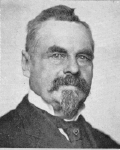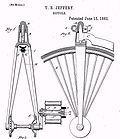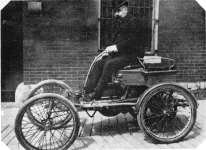
Thomas B. Jeffery
Encyclopedia
For the government official in colonial Nova Scotia see Thomas Nickleson Jeffery
 Thomas B. Jeffery (5 February 1845–2 April 1910) was an inventor and manufacturer of bicycle
Thomas B. Jeffery (5 February 1845–2 April 1910) was an inventor and manufacturer of bicycle
s and early automobile
s.
, Devon
, England
. At sixteen years of age he was working as a "mathematical instrument maker". At eighteen years of age, he emigrated to the United States
and became a resident of Chicago
, where "he was connected with the business of manufacturing telescopes". Later he was engaged in making models for the patent office
and in 1879 started in the bicycle business, being one of the pioneers in that field. He, with R. Philip Gormully, organized the Gormully & Jeffery Manufacturing Company
and began making the Rambler
.
by immersion in molten brass
. These techniques continued even after Gormully & Jeffery (G&J) and Rambler became names of the American Bicycle Company
, or Bicycle Trust, which was not known for the best manufacturing techniques in all of its lines.
By 1900, Gormully & Jeffery was the country's second-largest bicycle maker and Jeffery had gained fame for developing, among other things, the clincher rim that enabled pneumatic tires to be used.

's pneumatic tires for bikes were pretty much like the garden hoses they started out as. They were tubular in shape, and were secured to the bike rims by glue, and air pressure pressing them against the rim
. The rims were wooden, and had a concave surface for receiving the tube. These tires sometimes came off the rims, and a more secure type of tire was needed.
Thomas B. Jeffery came up with an improved tire that was held on by a wire that was embedded in the rubber of the tire, and the wire could be tightened onto the rim. He got a patent
on the ancestor of all clincher tires in 1882.
 He was one of America's first men interested in automobiles, and in 1897, he built the first Rambler motor car.
He was one of America's first men interested in automobiles, and in 1897, he built the first Rambler motor car.
Jeffery was serious about motor cars so he sold his stake in G&J and founded the Thomas B. Jeffery Company
. He used the G&J money to buy the old Sterling Bicycle Co.
factory in Kenosha, Wisconsin
, where he set up shop to manufacture automobiles on a large scale. From 1902 until 1908, Jeffery moved steadily to bigger, more reliable models. His cars were built on assembly line
s (the second manufacturer to adopt them -- Ransom Olds was first), and in 1903 he sold 1,350 Ramblers. By 1905, Jeffery more than doubled this number. One reason may have been because he went to the steering wheel
before 1904. In 1907, he was building a large variety of different body styles and sizes. Among them was a five-passenger, $2,500 Rambler weighing 2,600 pounds and powered by a 40-hp engine.
Thomas B. Jeffery died in 1910 while on holiday in Pompeii
, in Italy
, and after his death, Charles T. Jeffery
, changed the automotive branding from Rambler to Jeffery to honor Thomas B.
Ultimately, his family sold the manufacturing business to Charles Nash
, who renamed the company Nash Motors
and greatly expanded manufacturing efforts.
1863 - Jeffery emigrates to the US and moves to Chicago, Illinois.
1878 - Jeffery partners with Phillip Gormally and starts the Gormally & Jeffery Bicycling Manufacturing Company in Chicago, Illinois.
1882 - Jeffery invents the "Clincher Tire".
1897 - Jeffery's builds a rear-engine Rambler prototype using the Rambler name previously used on a highly successful line of bicycles made by G&J.
1899 - Positive reviews at the 1899 Chicago International Exhibition & Tournament and the first National Automobile Show in New York prompt the Jefferys to enter the automobile business.
1900 - Jeffery sells his stake in G&J to the American Bicycle Company.
1900 (Dec 6) - Thomas B. Jeffery finalizes a $65,000 deal to buy the Kenosha, factory of the defunct Sterling Bicycle Co. with money from the sale of his interest in the G&J.
1901 - Two more prototypes, Models A and B, are made.
1902 - First production Ramblers - the $750 Model C open runabout and the $850 Model D (the same car with a folding top). Both are powered by an 8-hp, 98cu. in., 1-cyl. engine mounted beneath the seat, and both are steered by a pioneering right-side tiller (a new concept at the time). First-year production totals 1,500 units making Jeffery the second-largest car maker behind Oldsmobile.
1910 (Mar 21) - Thomas B. Jeffery dies while on vacation in Pompeii, Italy.
1910 (Jun 10) - Charles T. Jeffery incorporates the family's car business as a $3 million public stock company.
1914 - Charles T. Jeffery replaces the Rambler name with the Jeffery moniker in honor of Thomas B. Jeffery.
1915 - Charles T. Jeffery survives the sinking of the RMS Lusitania
off the Irish coast
Thomas Nickleson Jeffery
Thomas Nickleson Jeffery was a colonial official and politician in Nova Scotia.He was born in Dorset, England. In 1798 he became an audit clerk in London and was, due to assistance from William Pitt the Younger, appointed collector of customs in Halifax, Nova Scotia...

Bicycle
A bicycle, also known as a bike, pushbike or cycle, is a human-powered, pedal-driven, single-track vehicle, having two wheels attached to a frame, one behind the other. A person who rides a bicycle is called a cyclist, or bicyclist....
s and early automobile
Automobile
An automobile, autocar, motor car or car is a wheeled motor vehicle used for transporting passengers, which also carries its own engine or motor...
s.
Early life
Thomas Buckland Jeffery was born on 5 February 1845 at 3 Mill Pleasant in StokeStoke, Plymouth
Stoke, also referred to by its earlier name of Stoke Damerel, is a parish, once part of the historical Devonport, England. Prior to 1914, it was a suburb of Devonport. In 1914, Devonport and Plymouth amalgamated with Stonehouse: the new town took the name of Plymouth...
, Devon
Devon
Devon is a large county in southwestern England. The county is sometimes referred to as Devonshire, although the term is rarely used inside the county itself as the county has never been officially "shired", it often indicates a traditional or historical context.The county shares borders with...
, England
England
England is a country that is part of the United Kingdom. It shares land borders with Scotland to the north and Wales to the west; the Irish Sea is to the north west, the Celtic Sea to the south west, with the North Sea to the east and the English Channel to the south separating it from continental...
. At sixteen years of age he was working as a "mathematical instrument maker". At eighteen years of age, he emigrated to the United States
United States
The United States of America is a federal constitutional republic comprising fifty states and a federal district...
and became a resident of Chicago
Chicago
Chicago is the largest city in the US state of Illinois. With nearly 2.7 million residents, it is the most populous city in the Midwestern United States and the third most populous in the US, after New York City and Los Angeles...
, where "he was connected with the business of manufacturing telescopes". Later he was engaged in making models for the patent office
Patent office
A patent office is a governmental or intergovernmental organization which controls the issue of patents. In other words, "patent offices are government bodies that may grant a patent or reject the patent application based on whether or not the application fulfils the requirements for...
and in 1879 started in the bicycle business, being one of the pioneers in that field. He, with R. Philip Gormully, organized the Gormully & Jeffery Manufacturing Company
Gormully & Jeffery
Gormully & Jeffery was an American bicycle company, founded in Chicago by Thomas B. Jeffery and R. Phillip Gormully in 1878. It marketed bicycles under the Rambler brand, was at one time the second largest bicycle manufacturer in the US, and was sold to the American Bicycle Company in 1900....
and began making the Rambler
Rambler (bicycle)
The Rambler is an American bicycle brand manufactured by the Gormully & Jeffery Mfg. Co., in Chicago from 1878 to 1900. This bicycle brand was created by Thomas B. Jeffery and was the predecessor to Jeffery's Rambler automobile....
.
Bicycle Manufacturer
Thomas B. Jeffery was an inventor and bicycle manufacturer with his partner, R. Philip Gormully, who built and sold Rambler bicycles through his company, Gormully & Jeffery Mfg. Co., in Chicago from 1878 to 1900. The Rambler was still a proud piece of machinery when low prices took precedence over high quality. Its body featured flared metal tubing for extra strength at the joints, which were brazedBrazing
Brazing is a metal-joining process whereby a filler metal is heated above and distributed between two or more close-fitting parts by capillary action. The filler metal is brought slightly above its melting temperature while protected by a suitable atmosphere, usually a flux...
by immersion in molten brass
Brass
Brass is an alloy of copper and zinc; the proportions of zinc and copper can be varied to create a range of brasses with varying properties.In comparison, bronze is principally an alloy of copper and tin...
. These techniques continued even after Gormully & Jeffery (G&J) and Rambler became names of the American Bicycle Company
American Bicycle Company
American Bicycle Company was an American bicycle company. American Bicycle was founded by Albert Augustus Pope, owner of the Columbia Bicycle. In 1898, the U.S. bicycle industry was caught in a downward spiral of market saturation, over-supply and intense price competition. Pope issued an affidavit...
, or Bicycle Trust, which was not known for the best manufacturing techniques in all of its lines.
By 1900, Gormully & Jeffery was the country's second-largest bicycle maker and Jeffery had gained fame for developing, among other things, the clincher rim that enabled pneumatic tires to be used.

Invention of Clincher Rim
DunlopJohn Boyd Dunlop
John Boyd Dunlop was a Scottish inventor. He was one of the founders of the rubber company that bore his name, Dunlop Pneumatic Tyre Company....
's pneumatic tires for bikes were pretty much like the garden hoses they started out as. They were tubular in shape, and were secured to the bike rims by glue, and air pressure pressing them against the rim
Rim (wheel)
The rim of a wheel is the outer circular design of the metal on which the inside edge of the tire is mounted on vehicles such as automobiles. For example, on a bicycle wheel the rim is a large hoop attached to the outer ends of the spokes of the wheel that holds the tire and tube.In the 1st...
. The rims were wooden, and had a concave surface for receiving the tube. These tires sometimes came off the rims, and a more secure type of tire was needed.
Thomas B. Jeffery came up with an improved tire that was held on by a wire that was embedded in the rubber of the tire, and the wire could be tightened onto the rim. He got a patent
Patent
A patent is a form of intellectual property. It consists of a set of exclusive rights granted by a sovereign state to an inventor or their assignee for a limited period of time in exchange for the public disclosure of an invention....
on the ancestor of all clincher tires in 1882.
Automobile Manufacturer

Jeffery was serious about motor cars so he sold his stake in G&J and founded the Thomas B. Jeffery Company
Thomas B. Jeffery Company
The Thomas B. Jeffery Company was an American automobile manufacturer in Kenosha, Wisconsin from 1902 until 1916. The company manufactured the Rambler and Jeffery brand motorcars. It was preceded by the Gormully & Jeffery Manufacturing Company and it was the parent company to Nash Motors, thus one...
. He used the G&J money to buy the old Sterling Bicycle Co.
Sterling Bicycle Co.
Sterling Bicycle Co. was a 19th-century American bicycle company first based in Chicago, Illinois before relocating to Kenosha, Wisconsin.-History:...
factory in Kenosha, Wisconsin
Wisconsin
Wisconsin is a U.S. state located in the north-central United States and is part of the Midwest. It is bordered by Minnesota to the west, Iowa to the southwest, Illinois to the south, Lake Michigan to the east, Michigan to the northeast, and Lake Superior to the north. Wisconsin's capital is...
, where he set up shop to manufacture automobiles on a large scale. From 1902 until 1908, Jeffery moved steadily to bigger, more reliable models. His cars were built on assembly line
Assembly line
An assembly line is a manufacturing process in which parts are added to a product in a sequential manner using optimally planned logistics to create a finished product much faster than with handcrafting-type methods...
s (the second manufacturer to adopt them -- Ransom Olds was first), and in 1903 he sold 1,350 Ramblers. By 1905, Jeffery more than doubled this number. One reason may have been because he went to the steering wheel
Steering wheel
A steering wheel is a type of steering control in vehicles and vessels ....
before 1904. In 1907, he was building a large variety of different body styles and sizes. Among them was a five-passenger, $2,500 Rambler weighing 2,600 pounds and powered by a 40-hp engine.
Thomas B. Jeffery died in 1910 while on holiday in Pompeii
Pompeii
The city of Pompeii is a partially buried Roman town-city near modern Naples in the Italian region of Campania, in the territory of the comune of Pompei. Along with Herculaneum, Pompeii was destroyed and completely buried during a long catastrophic eruption of the volcano Mount Vesuvius spanning...
, in Italy
Italy
Italy , officially the Italian Republic languages]] under the European Charter for Regional or Minority Languages. In each of these, Italy's official name is as follows:;;;;;;;;), is a unitary parliamentary republic in South-Central Europe. To the north it borders France, Switzerland, Austria and...
, and after his death, Charles T. Jeffery
Charles T. Jeffery
Charles Thomas Jeffery was an American businessman. He was the son of Thomas B. Jeffery, founder of Thomas B. Jeffery Company, an automobile manufacturer....
, changed the automotive branding from Rambler to Jeffery to honor Thomas B.
Ultimately, his family sold the manufacturing business to Charles Nash
Charles W. Nash
Charles Warren Nash was a United States automobile entrepreneur and served as an executive in the automotive industry.- Early life :...
, who renamed the company Nash Motors
Nash Motors
Also see: Kelvinator and American Motors CorporationNash Motors was an automobile manufacturer based in Kenosha, Wisconsin, in the United States from 1916 to 1938. From 1938 to 1954, Nash was the automotive division of the Nash-Kelvinator Corporation...
and greatly expanded manufacturing efforts.
Monopoly Fighter
Jeffrey contested several patents:- Fought the Pope bicycle patent and won.
- Fought the Selden bicycle patent and won.
Misinformation
Despite what internet sites may say, Thomas B. Jeffery was never a wagon builder.Timeline
1845 - Thomas Jeffery is born in Devon, England.1863 - Jeffery emigrates to the US and moves to Chicago, Illinois.
1878 - Jeffery partners with Phillip Gormally and starts the Gormally & Jeffery Bicycling Manufacturing Company in Chicago, Illinois.
1882 - Jeffery invents the "Clincher Tire".
1897 - Jeffery's builds a rear-engine Rambler prototype using the Rambler name previously used on a highly successful line of bicycles made by G&J.
1899 - Positive reviews at the 1899 Chicago International Exhibition & Tournament and the first National Automobile Show in New York prompt the Jefferys to enter the automobile business.
1900 - Jeffery sells his stake in G&J to the American Bicycle Company.
1900 (Dec 6) - Thomas B. Jeffery finalizes a $65,000 deal to buy the Kenosha, factory of the defunct Sterling Bicycle Co. with money from the sale of his interest in the G&J.
1901 - Two more prototypes, Models A and B, are made.
1902 - First production Ramblers - the $750 Model C open runabout and the $850 Model D (the same car with a folding top). Both are powered by an 8-hp, 98cu. in., 1-cyl. engine mounted beneath the seat, and both are steered by a pioneering right-side tiller (a new concept at the time). First-year production totals 1,500 units making Jeffery the second-largest car maker behind Oldsmobile.
1910 (Mar 21) - Thomas B. Jeffery dies while on vacation in Pompeii, Italy.
1910 (Jun 10) - Charles T. Jeffery incorporates the family's car business as a $3 million public stock company.
1914 - Charles T. Jeffery replaces the Rambler name with the Jeffery moniker in honor of Thomas B. Jeffery.
1915 - Charles T. Jeffery survives the sinking of the RMS Lusitania
RMS Lusitania
RMS Lusitania was a British ocean liner designed by Leonard Peskett and built by John Brown and Company of Clydebank, Scotland. The ship entered passenger service with the Cunard Line on 26 August 1907 and continued on the line's heavily-traveled passenger service between Liverpool, England and New...
off the Irish coast

